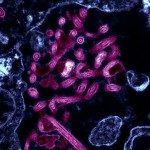Link to Pubmed [PMID] – 32805201
Link to DOI – 10.1016/S1473-3099(20)30593-4S1473-3099(20)30593-4
Lancet Infect Dis 2021 Jan; 21(1): 85-96
Prevention of mother-to-child transmission (MTCT) of hepatitis B virus (HBV) involves neonatal immunoprophylaxis, with a birth dose of hepatitis B vaccine and immune globulin, and provision of peripartum antiviral prophylaxis in highly viraemic women. However, access to assays to quantify HBV DNA levels remains inadequate in resource-poor settings. This study was commissioned by WHO and aimed to identify the HBV DNA threshold for MTCT, to assess the sensitivity and specificity of hepatitis B e antigen (HBeAg) testing to identify pregnant women with HBV DNA levels above this threshold, and to predict MTCT of HBV infection on the basis of HBeAg testing.For this systematic review and meta-analysis, we searched the PubMed, EMBASE, Scopus, CENTRAL, CNKI, and Wanfang databases for studies of pregnant women with chronic HBV infection without concurrent antiviral therapy, published between Jan 1, 2000, and April 3, 2019. Studies were eligible for inclusion if MTCT in mother-child pairs could be stratified by different levels of maternal HBV DNA during pregnancy, if maternal HBeAg status could be stratified by HBV DNA level, and if the MTCT status of infants could be stratified by maternal HBeAg status during pregnancy. Studies that selected pregnant women on the basis of HBeAg serostatus or HBV DNA levels were excluded. Aggregate data were extracted from eligible studies by use of a pre-piloted form; study authors were contacted to clarify any uncertainties about potential duplication or if crucial information was missing. To pool sensitivities and specificities of maternal HBeAg to identify highly viraemic women and to predict MTCT events, we used the DerSimonian-Laird bivariate random effects model. This study is registered with PROSPERO, CRD42019138227.Of 9007 articles identified, 67 articles (comprising 66 studies) met the inclusion criteria. The risk of MTCT despite infant immunoprophylaxis was negligible (0·04%, 95% CI 0·00-0·25) below a maternal HBV DNA level of 5·30 log10 IU/mL (200 000 IU/mL) and increased above this threshold. The pooled sensitivity of HBeAg testing to identify HBV DNA levels of 5·30 log10 IU/mL or greater in pregnant women was 88·2% (83·9-91·5) and pooled specificity was 92·6% (90·0-94·5). The pooled sensitivity of HBeAg testing in predicting MTCT of HBV infection despite infant immunoprophylaxis was 99·5% (95% CI 91·7-100) and pooled specificity was 62·2% (55·2-68·7).Maternal HBV DNA of 5·30 log10 IU/mL or greater appears to be the optimal threshold for MTCT of HBV infection despite infant immunoprophylaxis. HBeAg is accurate to identify women with HBV DNA levels above this threshold and has high sensitivity to predict cases of immunoprophylaxis failure. In areas where HBV DNA assays are unavailable, HBeAg can be used as an alternative to assess eligibility for antiviral prophylaxis.World Health Organization.



